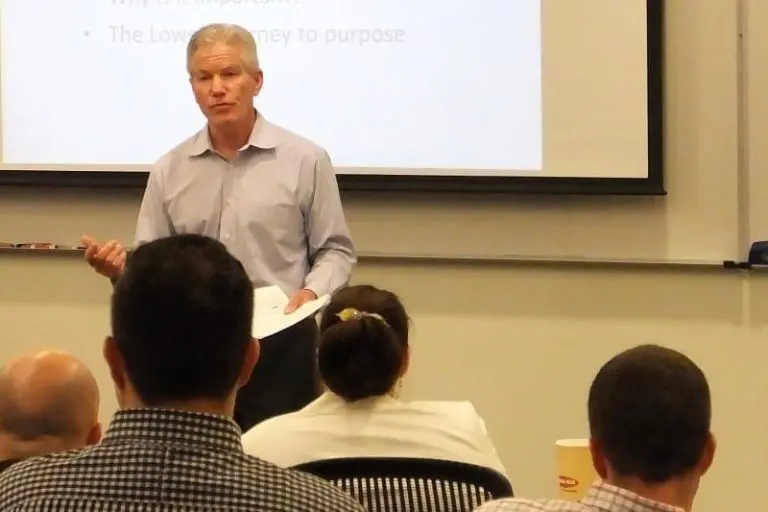Making a statement: Purpose trumps mission

Lowe’s Greg Bridgeford (MBA ’82) on defining what matters for your organization
By Alicia W. Roberts
It took months and months of research and discussion – and it continues even today. But when Lowe’s Companies Inc. settled on its purpose as a corporation, it was elegant, it was powerful, and it was short:
“Our purpose is to help people love where they live.”
And it was like a Wizard of Oz Tin Man moment for then Chief Customer Officer Greg Bridgeford. “We always had a heart,” he told an audience of students, faculty, staff, alumni and members of the business company at a School of Business Lunch & Learn session October 9 at the WFU Charlotte Center. “We just didn’t know it was there.”
Bridgeford, who retired from Mooresville, N.C.-based Lowe’s in 2014 after 32 years with the company, said his interest in creating a purpose-driven business actually took root when he was an MBA student at the School. His professor was teaching from a book called “The Functions of an Executive” by Chester I. Barnard, a text he still keeps close by today.
Barnard suggested that “at the core of organizations is this unifying concept called purpose. An organization has to define a purpose for long-term continuity of success,” Bridgeford explained. The executive must ensure that everything the company does supports that purpose. It’s more than a mission statement.
In fact, unlike its statement of purpose, the Lowe’s mission reads like this: “We will provide customer-valued solutions with the best prices, products and services to make Lowe’s the first choice for home improvement.”
Bridgeford said it is direct and descriptive, “but it doesn’t tell why we do it. If it (a mission) doesn’t have heart, does it do its job?”
To distill the Lowe’s purpose into that one simple statement – “to help people love where they live” – Bridgeford’s team spent time in markets from coast to coast, at hundreds of stores at all levels. Employees kept journals and wrote blogs. They connected through chat rooms.
What Lowe’s found was that the company had underestimated the emotional tie people have with their homes at different stages – and the emotional connection employees made when helping their customers.
“The emotional part of the work and the impact we can have on other lives is crucial,” Bridgeford said. “It’s the difference between a mission statement and a purpose.”
Adam Coremin (MBA ’16), vice president-strategic accounts for Precept Wine, is part of the team determining his company’s vision and purpose. He said that hearing about how Lowe’s did it – and the dedication and time required – was helpful.
“You almost throw vision, mission and value proposition into a blender, and you have purpose,” the Charlotte Saturday student said. “It’s a challenge we need to present to ourselves. Finding that emotional connection – that will take time.”
It does take a lot of time, Bridgeford said, and a great deal of exploration. The Lowe’s team had to consider all of the roles the company plays, from helping with joyful moments such as getting a nursery ready for a new baby to rescuing people in times of natural disaster such as Hurricane Hugo.
“Transformational change is a tough, tough thing to accomplish,” he said. “True change, and true adoption and inclusion of something like this takes years and takes tough slogging, from the CEO on down.”
He recommends you start with changing your relationship with the customer. Lowe’s scans public channels for phrases on home improvement, the Lowe’s name and the names of competitors to measure what emotions are tied to specific home improvements. Customers walk through stores wearing electrode caps to log emotional responses to displays, sections and products as part of the company’s research.
All to help the company remember the heart in everything its workers do, every day.
“At one of the end spectrum, we help people survive, and at the other end of the spectrum, we help people thrive,” Bridgeford said. “You don’t know which end of the spectrum you’re going to be serving that day. You just know you’re going to be in service.”
Bridgeford told the audience the company’s purpose can help:
- Unite the team
- Prioritize the work stream
- Guide decisions
- Make everything more efficient
- Answer the why for all the whats and hows the team does every day.
“These are just words – but they don’t mean anything unless you believe in them,” Bridgeford said. “You need to wrestle with them and make them relevant to your work every day.”
In the Lowe’s case, every action by the team helps people love where they live. And Bridgeford says, for any company’s case, it helps you get up and love what you do every day.
Alicia W. Roberts is a freelance writer, editor and communicator, based in Charlotte, N.C.